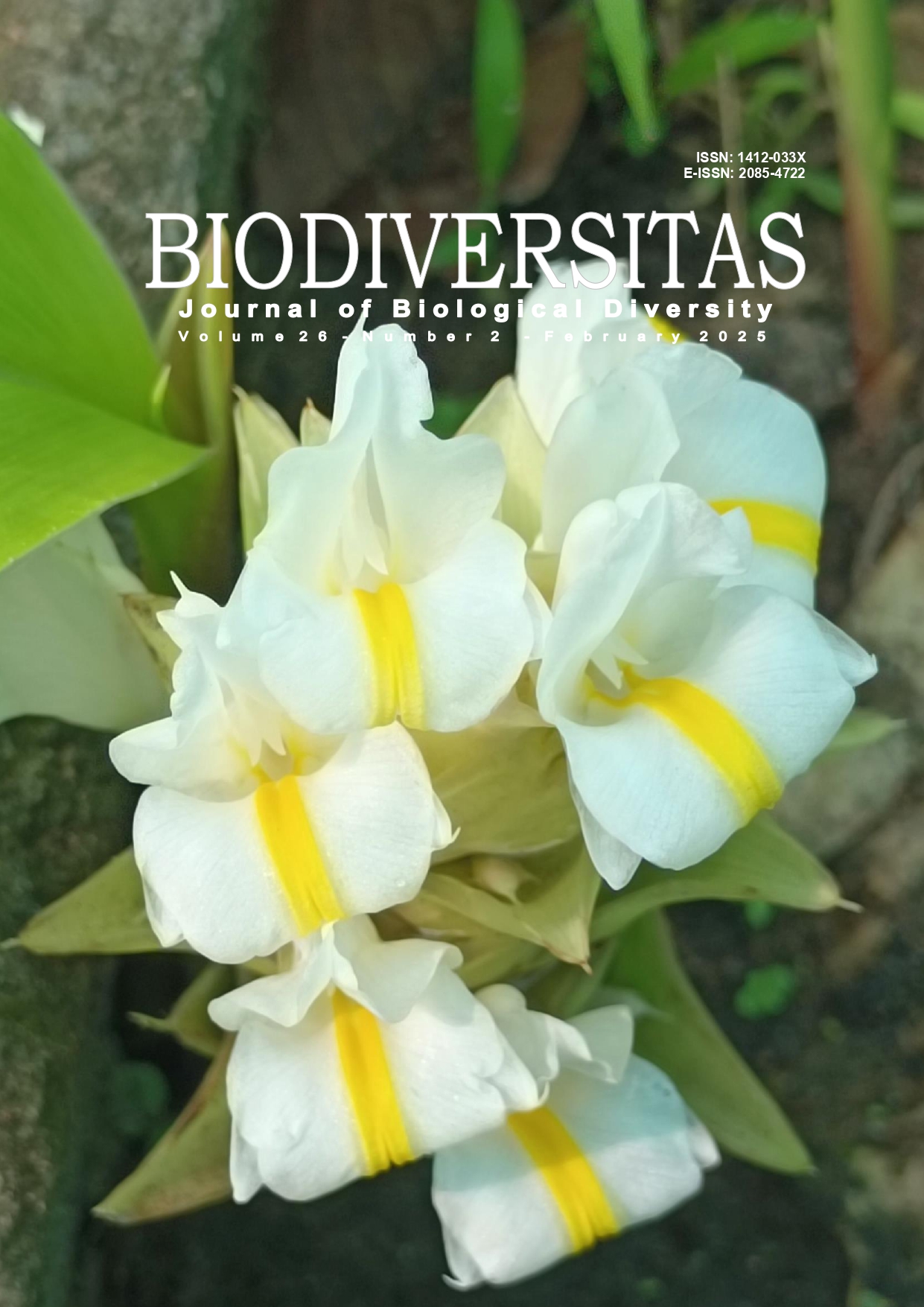Bat species on Timor Island, Indonesia
##plugins.themes.bootstrap3.article.main##
Abstract
Abstract. Pramatana F, Hasibuan MM, Tohir RK, Tae CE, Fathurohman F, Maryanto I, Wiantoro S, Supriatna N, Arsa IGBA, Rammang N, Marawali A. 2025. Bat species on Timor Island, Indonesia. Biodiversitas 26: 564-571. Timor Island, East Nusa Tenggara Province, Indonesia, is one of the Lesser Sunda regions with unique biodiversity. Updating information as a database needs to be carried out to become the basis for conservation actions at the species and ecosystem levels, considering that bat species are very vulnerable to habitat destruction. This research aims to collect a checklist of bat species on Timor Island by selecting sampling locations based on the habitat's climatic conditions. The study was conducted in 10 research locations, including conservation, forest, village, and one disturbance area. Data was collected using mist nets, harp traps, and interviews with local communities. Suppose there is a record or a species that is doubtful in its identification, a specimen will be made and will then send samples to the Museum Zoologicum Bogoriense, Indonesia. Bat research in the Timor Island area was carried out in 1979 and recorded twenty-two species of bats. However, the locations in that research are spread across the Timor Leste region. This study on Timor Island, Indonesia, recorded twenty bat species, including a new record of Dobsonia viridis in the Lesser Sunda Island region. This species was previously documented only in Celebes and Moluccas.
##plugins.themes.bootstrap3.article.details##
Most read articles by the same author(s)
- YULI S. FITRIANA, EKO SULISTYADI, RIZKI KURNIA TOHIR, MHD MUHAJIR HASIBUAN, FARID RIFAIE, IBNU MARYANTO, ARIE MULIA LUBIS, M. FAJRUR RIFQI, Population study of long-tailed macaque (Macaca fascicularis) on Deli Island, Banten, Indonesia , Biodiversitas Journal of Biological Diversity: Vol. 25 No. 1 (2024)
- FAHMA WIJAYANTI, IBNU MARYANTO, Diversity and pattern of nest preference of bat species at bat-dwelling caves in Gombong Karst, Central Java, Indonesia , Biodiversitas Journal of Biological Diversity: Vol. 18 No. 3 (2017)
- TILTJE ANDRETHA RANSALELEH, INDYAH WAHYUNI, MARTHA KAWATU, MEIS JACINTA NANGOY, SIGIT WIANTORO, Behavior of the black flying fox, Pteropus alecto (Chiroptera: Pteropodidae) in cages , Biodiversitas Journal of Biological Diversity: Vol. 22 No. 12 (2021)
- YASINTA LETEK KLEDEN, LINCE MUKKUN, MELYCORIANDA HUBI NDAPAMURI, FADLAN PRAMATANA, The migratory locust (Locusta migratoria) as a potential source of protein and biopolymer compounds in the future , Biodiversitas Journal of Biological Diversity: Vol. 24 No. 11 (2023)
- Husni Mubarok, Niken Satuti Nur Handayani, Ibnu Maryanto, Tuty Arisuryanti, Karyotype variation in lesser short-nosed fruit bat Cynopterus brachyotis (Müller 1838) from Special Region Yogyakarta, Indonesia , Biodiversitas Journal of Biological Diversity: Vol. 22 No. 5 (2021)
- FEVI MAWADHAH PUTRI, AHMAD SYUKRON PRASAJA, PUTRA TRI KURNIAWAN, YULI SULISTYA FITRIANA, SIGIT WIANTORO, Population of Long-tailed Macaque (Macaca fascicularis) at several habitat conditions in Jambi Province, Indonesia , Biodiversitas Journal of Biological Diversity: Vol. 25 No. 9 (2024)
- FADLAN PRAMATANA, YUSRATUL AINI, NIXON RAMMANG, YOSEP SERAN MAU, I G.B. ADWITA ARSA, ARIEF MAHMUD, Predicting of Komodo dragon's potential prey habitat suitability using MaxEnt in Riung Nature Reserve, Flores, East Nusa Tenggara, Indonesia , Biodiversitas Journal of Biological Diversity: Vol. 24 No. 6 (2023)
- TILTJE ANDRETHA RANSALELEH, MARTHA KAWATU, INDYAH WAHYUNI, JANE ONIBALA, MEIS JACINTA NANGOY, SINTYA UMBOH, UNSTAIN N. W. J. REMBET, SURYO SAPUTRO, SIGIT WIANTORO, Fruit bats trade in the traditional markets of South Minahasa, North Sulawesi, Indonesia , Biodiversitas Journal of Biological Diversity: Vol. 25 No. 2 (2024)

